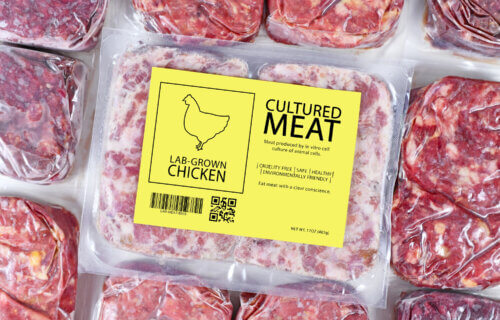LOS ANGELES — An historical milestone in the food industry was reached Wednesday when the USDA approved the sale of chicken grown in laboratories from cells, rather than slaughtered meat. The product had already been approved by the FDA in November 2022.
Two companies based in California, “Good Meat” and “Upside Foods,” will be selling the products. “Cultured meat” is the preferred term, designated by the USDA. It is produced in steel tanks using cells from living animals. The products are real meat, not vegan, vegetarian, or plant-based protein.
For years, the popularity of sustainable alternatives to slaughtered meat has been growing. Supporters say that using the products can have a favorable effect on climate change. According to the United Nations, 14.5 percent of global greenhouse emissions come from industrial animal farming. Transportation of meat also produces carbon dioxide and methane, which would be reduced by use of the cultured product.
In a poll administered by the Associated Press (AP) – NORC Center for Public Affairs Research, half of Americans say they would try the new meat. Many who won’t try it simply feel the concept sounds too over the top for their liking. Within the industry they call it the “ick factor.” Consumers also express concern about the safety of lab-produced chicken.
The cultured meat is formed in large sheets. Upside Foods cuts and forms the product into shapes like cutlets and sausage. The company says they will be able to produce about 50,000 pounds of meat per year, with a goal of expanding to 400,000 pounds per year. Good Meat forms its sheets into cutlets, nuggets, and shreds. Company officials declined to disclose their production capacity and goals. The current chicken industry produces 50 billion pounds per year.
Initially, the Upside Foods chicken will be used at the upscale restaurant Barr Crenn in San Francisco. The Good Meat product will be used at an undisclosed restaurant in Washington, DC.
Neither company would quote a price for the product, although it’s expected it will be high. With production being limited and high-tech, the companies estimate that the price will eventually be similar to the most expensive organic chicken available, which is about $20 per pound. For these reasons, don’t expect to see it in grocery stores for years to come.
Good Meat has sold its product in Singapore since 2020. There are about 150 companies in the world working on the development of cultured meats, including pork, lamb, fish, and beef, in addition to chicken.
Current research in protein alternatives
An innovative project at the University of California (UCLA) is exploring how physical forces affect cells – a field called mechanical biology. Dr. Amy Rowat, founding director of Science and Food, a campus organization, is especially interested in how the forces may be important to developing cultured meat. Her goal is the development of laboratory-made steaks available in grocery stores for consumers.
Rowat views the scientific endeavor as an aspect of a greater research mission. “Very broadly, our work is driven by the desire to advance both human and planetary health,” Rowat says in a statement.
Rowat cites one of the many deleterious effects of the COVID-19 pandemic — that of disruptions to the supply chain adversely affecting the availability of household food staples — as an example of why expanding the types and availability of protein-rich foods would benefit society.
“Having other methods to produce animal-like protein can help increase the resilience of our food system,” she explains.
In addition to the increase in the availability of protein-rich foods, laboratory produced meats could solve problems and improve other pertinent issues, Rowat explains. Cultured meat has the potential to cause less greenhouse gas emission, reduce antibiotic use, and use less land mass, pound-for-pound, than meat from livestock.
“I see cultured meat as a complement to other solutions, such as regenerative agriculture,” Rowat says. “An important aspect is simply to have these alternative protein sources out there.”
The costs and the challenges involved with producing laboratory-cultivated meat for consumption at consumer scale are substantial obstacles. Rowat’s research includes looking for methods that add efficiency to the manufacturing processes of cultured meat.
“The holy grail in this work is to develop a piece of meat that is more spatially patterned, like a filet mignon, and marbled with fat,” she adds. “Fat is really important for mouthfeel, for texture, for flavor and for nutrition. That’s the next frontier we’re working on now, and we’re grateful for the Noble Family Innovation Fund support. We’re excited for the next level of findings, which we think will make cultured meat more delicious and healthful.”

Hey Faith,
Interesting article thanks for sharing…. not to sure if I’m ready for “cultured meat” or “fish”.
It seems like I’m always searching for that “perfect” recipe when I BBQ. Usually Happy with the outcome, if I switched to fake stuff I can’t believe I’d ever be happy, and would wonder if it’s the product or the cooking….